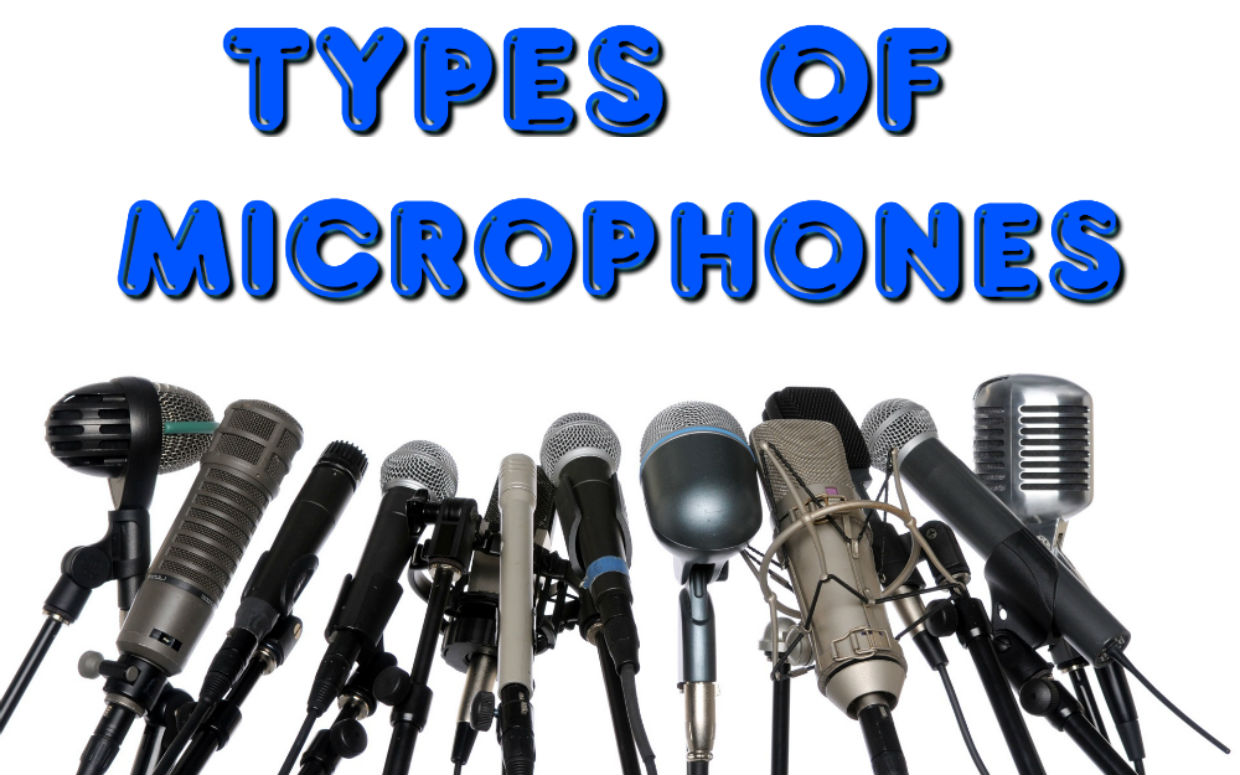Do you want to learn how to choose a good microphone among a huge variety of models? Today, we will tell you about it!
Manufacturers of sound technology today provide consumers with a huge selection of different microphones. A variety of types, characteristics, price range allows everyone to arrange a small studio at home. But before choosing a microphone, you should precisely determine the purpose for which it is intended. It is wrong to start from just brand awareness. If the microphone type is selected incorrectly, then the pleasure of working with it will not be.
Let’s start with the types of microphones according to the principle of their action.
First of all, the microphones are divided into dynamic and condenser.
Dynamic microphones are more in demand among variety singers and are used for performing on stage because they do not need an external power source, they have uniform frequency characteristics. But for a quality voice recording they are not suitable because they make the sound “flat” and “simple”.
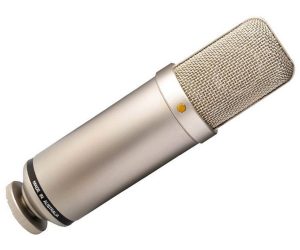
Condenser microphones
Condenser microphones are great for recording voice in the studio. It has a cardioid diagram of the sound, and also uniform frequency characteristics. Such a microphone makes the voice more alive, fills it with colors, transmits all the shades of spoken language. This kind of device is actively used by musicians to record songs and is also popular among the leading on the radio.
- Characterized by a wide frequency range.
- A wide range of models that have different overall dimensions and purposes.
- A high level of microphone sensitivity allows you to transmit the most natural and transparent sound. This feature can be attributed to the main advantage of capacitor models.
- Affordable price and the ability to make purchases online.
- Have a more transparent and clean sound.
- The need for additional power is a major drawback.
- Microphones need to be treated very carefully. They have a fairly fragile body, which can easily be damaged by falling.
- The condenser models are also afraid of the negative effects of moisture and sudden temperature changes. Therefore, you need to create special conditions for their use.
To properly select a microphone, you need to understand its technical characteristics or at least have a general idea about them. The quality of sound transmission is influenced by:
- directivity;
- sensitivity;
- frequency range;
- sound pressure level.
The directivity indicator characterizes how well a microphone can perceive sounds that affect it from different sides.
By directionality, there are three main types of microphones:
- omnidirectional microphones;
- unidirectional (directional) microphones;
- bi-directional microphones.
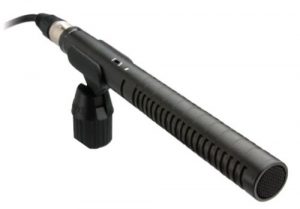
Directional microphones
Ordinary microphones are able to record human speech at a distance not exceeding several tens of meters. To increase the distance at which you can produce an audition, the use of a directional microphone is practiced. In other words, this device collects sounds only from one direction, i.e. it has a narrow polar pattern. Such devices are widely used not only in exploration but also by journalists, hunters, rescuers, etc.
In the simplest of them, a narrow polar pattern is formed by using a long tube and a microphone installed in it. The tube is disguised as a cane or umbrella. In more complex designs, several tubes of different lengths can be used – this is the so-called organ-type microphone. Such a microphone is able to catch the sounds of the voice at a distance of up to 1000 meters. The microphones also have a high directivity, in which the radiation pattern is formed by a parabolic sound concentrator.
Directional microphones are a subclass of conventional microphones that can pick up an acoustic signal from a specified point or small area. Such devices screen out all sound waves coming from other directions, and the selected signal is amplified, making it possible to hear speech or sounds from a distance far beyond the limits of normal human perception.
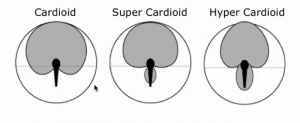
Directional patterns are important when the microphone is used in a noisy environment, for example, for a vocalist’s performance at a concert. The cardioid, super cardioid and hyper cardioid microphones exclude all sounds except the voice of the singer. The sound is obtained purer, and feedback is reduced to a minimum.
In addition to the above technical characteristics, there are others – compactness, weight, cable length, etc., which do not particularly affect the sound but make the use of a microphone more convenient.
In its purpose, the microphones are divided:
- on-camera;
- lavalier;
- manual;
- desktop;
- hanging;
- microphones over-the-ear;
- secret, which attaches to musical instruments, etc.
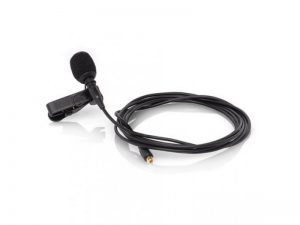
Lavalier microphones
Lavalier microphones are a separate category of equipment. They are actively used not only on television, but also for filming, theatrical productions, and vocal performances. Such devices have good sound, miniature dimensions, excellent technical characteristics.
How to choose a lavalier microphone?
Products of this type differ from each other in different indicators: frequency range, size, sensitivity, attachment mechanism. Most microphones of the lavalier type are attached to the clothes.
Each product has its own technical characteristics, purpose. A feature of all lapel microphones is their high performance of noise rejection. Most of them have a design that minimizes sound distortion.
In addition, lavalier microphones differ in the precise capture of sound at a distance. Such a technique can be used without problems, both indoors and out. High intelligibility of speech is one of the most basic characteristics.
Wireless models have a wide scope of use. They are an indispensable subject during filming, presentations, various talk shows.
The biggest plus of the lavalier models is their compact size. Although the device is small in size, it is not inferior in performance to more dimensional microphones.
- compatibility with different equipment;
- multifunctionality;
- convenient fastening;
- the device will be invisible to others;
- suitable for filming on the street.
- the closer the microphone to the mouth, the more low frequencies appear in the voice;
- when you move, you will hear the rustling of clothes.
Any wired or wireless lapel microphone can be a good choice. It is necessary to correctly determine the model, carefully study its technical characteristics.
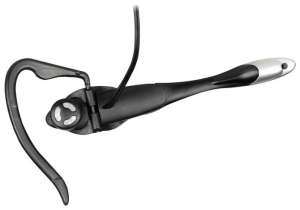
Microphones over-the-ear
Headphones (microphone over-the-ear) work perfectly for their intended purpose, as they are located in a natural place for normal speech transmission. They are insensitive to changing the position of the head. There are also subminiature head microphones of corporal color fixed to one ear, which are highly invisible, practically do not affect the hairstyle and do not squeeze the head. But such a miniaturization is also a compromise. After all, if the dimensions of the membrane are too small, it is difficult to achieve a sound quality due to the elementary laws of physics. As a rule, such subminiature head microphones are designed for the same conditions of use as lavalier ones, so they often have a circular pattern.
The usual head microphone is noticeable, interacts with the hair, can squeeze the head, so the success of its use largely depends on individual physiological characteristics.
The head design is used both for vocals in noisy scenic performances and for a quiet speaker’s speech in a quiet studio.
- It is located closer to the mouth. Therefore, you are guaranteed to receive a constant gain and clear sound.
- Microphones can be fixed on one ear or have an occipital arch and be attached to both ears at the same time. The second option guarantees a more reliable fixation of the microphone, and a light metal frame will not bring discomfort even with prolonged use.
- They are very neat and not very noticeable.
- In some cases, it can be difficult to disguise them.
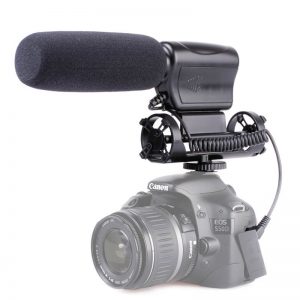
DSLR Camera Microphones
Modern digital photo and video cameras are able to shoot video of excellent quality. This video quality is not inferior to the material that was shot on expensive professional equipment. The only disadvantage of shooting on simple digital cameras is that they are not able to record the sound of proper quality. It is for these cameras the special microphones were created, which allow you to record audio of the superior quality.
The microphone is attached to the camera using the “hot shoe” mount and connected via the stereo jack. Thus, the microphone makes it possible to make a better sound recording under the same conditions.
There is a large number of microphones for video cameras with different directional patterns. The most popular today are microphones from Rode.
When choosing a microphone for a video camera, you should pay attention to the microphones with different sensitivity, resistance and sound pressure level.
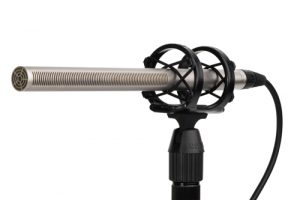
Shotgun microphones
The microphone-gun is intended for the use by journalists and TV reporters. Its design is dictated by the features of the work of these specialists.
The equipment is intended for the use in noisy places and on the street. It is easy to direct it to a certain point and catch the sound emanating from it. In this case, the device filters all sounds coming from the side.
It has a good range of work and allows you to interview, report, etc. The microphone can be connected directly to a recording device or camera.
Features of the shotgun microphone
The microphone gun for the camcorder is designed for the use on film and television. It is perfect for outdoor filming. A quality microphone gun must meet the following requirements:
- to be distinguished by a pronounced directivity and to work in a wide range;
- to have a high sensitivity in the direction of the axis;
- qualitatively filter third-party sounds;
- do not create your its own noise;
- create a minimum of distortion.
Such devices are often equipped with a variety of filters, such as muffling low frequencies, softening high and medium, etc. All this provides a cleaner and more uniform sound.
Another important feature is a waterproof case that allows you to use the microphone in all weather conditions and during shooting various scenes using an artificial rain.
Used in the reportage video filming, microphones, as a rule, are condenser and highly directional. This is due to the fact that the microphone must take the sound exactly from the point where the lens is directed, and not perceive the sounds coming from the source outside the frame.
If you are looking for a microphone for studio recording, you need to take into account the acoustic properties of the room where the recording will take place, so you can determine the direction of the microphone.
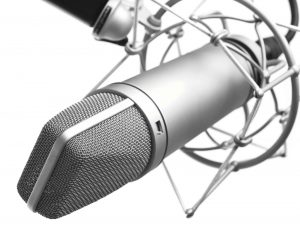
Studio microphones
A professional studio microphone for voice recording features great sensitivity from a conventional model. However, it can be used in various voice applications. In addition, it should be noted that there is a special technology of noise reduction. As a result, the voice is recorded always clearly and without any extraneous sounds.
The resistance parameter of the studio devices is at the level of 2 kOhm. The working voltage is as much as 1.5 V. The average frequency of studio microphones varies around 50 MHz. In addition, they are characterized by high performance and simple installation.
How to choose a good model?
To select a good microphone for voice studio recording, first of all, you should pay attention to the frequency indicator. Its minimum values should be at the level of 20 Hz. In this case, the maximum device must be able to produce a frequency of 18,000 Hz. The sensitivity of the microphone is welcomed at least 33 dB. Adjusting the volume should be comfortable. Another step is to check the operation of the phase switch before purchasing.
For comfortable studio voice recording, many people prefer to choose models with a signal level indicator. To make the sound clean, a low-cut filter is required. Among other things, you need to clarify the ability of the device to support for all available formats.
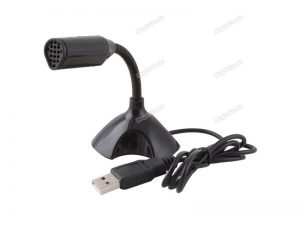
USB microphones
Microphones with a USB interface appeared not long ago, but already firmly occupied their niche in the market of the professional audio equipment.
What is a USB microphone?
This is a symbiosis from the microphone itself (usually a condenser) and an audio interface (a USB sound card), through which there is the process of converting the analog microphone signal to digital, which is transmitted via a USB channel to a personal computer for recording and further processing.
Why do you need a USB microphone?
If you need to record any audio signal (voice, guitar, background sound, etc.) on your computer quickly and with good quality, then you do not need to buy a separate studio microphone, a professional sound card and think about how to connect it to your computer. Just buy a microphone with a USB interface!
To connect such a microphone will not be difficult! It is not more difficult than connecting an ordinary computer mouse. It must be connected to an available USB port, your operating system will recognize the new device and install it automatically. You just need to set up your favorite recording program for it. To use a USB microphone, most people do not need specialized knowledge and skills in working with recording equipment.
USB microphones are the best choice for podcasting, deaths, vocals and turnips. Also, they are indispensable for online conferences, meetings, webinars, negotiations, Skype, etc.
Features when working with USB microphones!
Yes, a USB microphone is very convenient! But when working with it, you should consider some features:
- There may be some signal delay (up to 1s.), depending on the USB microphone model.
- It is not possible to connect a USB microphone through a USB hub since such equipment requires a free USB port for direct connection.
- The USB cable for connecting to a computer cannot be too long (maximum 3-5 meters).
- Most USB microphones do not have a level control recording directly on the device.
- Most of the models of USB microphones do not have a headphone output for monitoring real-time recording, but there are also models with a headphone output.
- Compactness, mobility.
- Easy to connect and configure.
- Affordable price
- High-quality recording.
- No need for additional expensive equipment.
- Sometimes, there is no output for headphones
- Can not be used as a sound card/
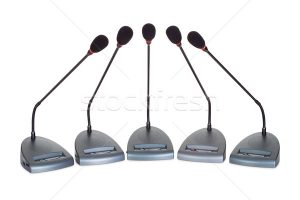
Conference microphones
Microphones for conferences have long been an integral part of any negotiation process. And in the era of permanent seminars, conferences, meetings, business meetings, there is a need for certain technical equipment that will meet all modern requirements. And if it concerns any kind of conferences, then quality microphones are the first thing, to begin with.
A conference microphone is a small device mounted on a flexible holder. Its function is to clearly convey the voice of the speaker. He focuses exclusively on the voice, ignoring extraneous sounds. This is due to the sensitivity of the microphone to the sound, depending on the direction or angle from which the sound comes. And this is called orientation.
A microphone for good quality meetings should have the following characteristics
By the mechanism of converting sound into an electrical signal, the microphones are:
- dynamic;
- condenser.
If we talk about the most preferred conference microphone, then the dynamic type (because of the characteristics of its design) can produce a less quality sound.
The condenser microphones are arranged in such a way that the diaphragm helps to achieve a higher sensitivity, and the directivity contributes to the fact that one can speak into the microphone and not be afraid that another extraneous sound will be transmitted along with the voice.
In connection with the above, it is recommended to use condenser microphones for any conferences.
How to choose a microphone for conferences?

Wired are cheaper, but have wires. If the mobility for you is not a priority, and you do not plan to use the room (where the microphone system for conferences will be located) for other needs – pay attention to wired ones.
If you are going to hold conferences in halls where a full-fledged wired installation is impossible (theaters, museums, etc.), in conditions where the mobility of unfolding and folding of the system is important, then your choice is a conference system with wireless microphones.
Determine the type of microphones according to the direction of the action.
There are narrowly and broadly directed.
If you have a large conference hall with the presence of a large number of participants and speakers, then the narrowly directional microphones are the best choice, since each of the microphones has a limited perception zone and will not perceive the voice of the other speaker.
If you plan to hold events in a small room and there is an opportunity to put a microphone in the middle of the table, then the wide directional mic will be an excellent option.
Additional features
Also, the microphones for conferences can have different additional features. Depending on the case, you may need a headphone jack or an additional removable microphone.
A quality conference microphone must have the following characteristics:
- low sensitivity to interference, which arises from mobile phones and other office equipment;
- long service life;
- in some cases – the presence of a wireless connection to the central unit of the conference system;
- the quality of material and assembly;
- ergonomic, stylish and compact design.
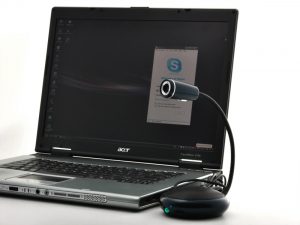
Microphones for computer
These are the simplest models that can be found among a wide range. As a rule, they are used for communication with Skype and other similar programs. In addition, they are used for scoring of videos. They are not equipped with a lot of functions, modes, and effects because it’s all not necessary for such models. The main requirement for these devices is convenience and ease of use.
Microphones for a computer can be divided into three main types:
- lavalier;
- desktop;
- computer headset.
The lapel microphone has a clothespin so that it can be attached to the user’s clothes. These devices are quite convenient to use due to their compact size, but it is not worth expecting high-quality sound from them. In this respect, they are rather primitive.
The desktop devices in the kit have a special stand, on which, as a rule, there are additional buttons for control. The microphone and the stand can be a single design or be separate. Before making a choice in favor of a desktop type, you need to make sure that there is enough space on your desk to install it because some models are quite cumbersome.
A computer headset is the most convenient device. The set, which consists of headphones and a microphone (they are connected in one device), is attached with a special holder, it is at the level of the corner of the mouth, which provides an excellent audibility to the interlocutor.

Microphones for iOS
Some users want to turn the iOS gadget into a recorder designed to record high-quality sound. For such purposes, iPad/iPhone microphones are used. Due to the abundance of models, buyers can find the most suitable accessory.
Features of microphones for iPad/iPhone
Modern manufacturers produce various microphones for iPad/iPhone. The devices have different connectors. Such models of microphones differ in compact sizes. If necessary, they can be used for both in working order, and for personal needs. Digital portable microphones are useful accessories for singers, musicians, as well as for all users who want to get a quality, clear sound.
Advantages of microphones for iPad/iPhone
Modern models of microphones are equipped with a powerful preamplifier with a low level of noise. The microphones for the iPad/iPhone remain operational even at the highest possible sound pressure. Due to this, the device performs high-quality recording of loud sounds. On the case of devices, there is a gain control, as well as a convenient LED-indicator (the signal level is displayed, its state). The microphones are equipped with a special mini-jack, which is designed to connect headphones.
Among the positive features of the recording devices the following qualities are included:
- the device converts the analog signal to digital;
- the microphone provides studio-quality sound recording;
- the built-in controller allows you to adjust the input level;
- devices allow you to record acoustic instruments, vocals;
- microphones for iPad/iPhone are small in weight, small in size.
Small microphones are designed to work with tablets, smartphones on iOS. The microphone is connected using a special headphone jack. Compact devices are great for recording lectures, interviews, and speeches.
What is binaural sound? Usually, this is a two-microphone recording designed for listening only in headphones.
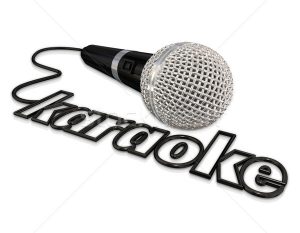
Karaoke microphones
In any set of karaoke equipment, whether amateur or professional, the microphone is an essential element of the entire system. It is on it the quality of the transmission of real sound to the acoustic system depends on.
A microphone is the most recognizable karaoke attribute. When deciding which microphone to buy for karaoke, it is important to have sufficient information on this issue so that the choice is literate.
What are the characteristics of a good microphone and what characteristics do you need to pay attention to?
Perfect sound quality
In addition to the assembly and good faith of the manufacturer, on the quality of sound affects the ownership of microphones to a condenser or to a dynamic type.
Condenser microphones of the latest generation transmit vocals in the quality as close as possible to studio standards. The sound transmitted by them is deep, soft and pure, saturated with all the richness of the overtones. And to obtain this result, no additional audio equipment or filters are required.
Dynamic microphones are not sensitive to additional interference. They are widely used in the karaoke industry, at concerts and business events (conferences, exhibitions, symposia), etc.
Reliability and durability
A good microphone should be strong. It does not matter which material the body is made of – plastic or metal. The main thing is that the fall and other mechanical effects are not reflected in its work.
A good microphone is very reliable in use and is not afraid of active operation. Resistance to mechanical damage has made them in demand in many karaoke establishments. No casual gusts of the wind, no breath, no droplets of saliva are not terrible for a reliable microphone.
Maximum comfort
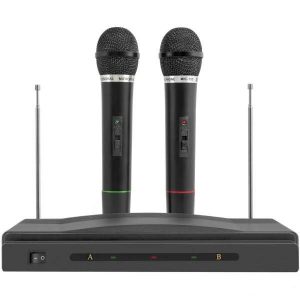
Choosing which of the microphones is better for karaoke should be based on the specific considerations of each vocalist. Both types of devices, equipped with a cable and without it, are equally in demand and popular.
For home karaoke, a microphone with a cord length of 3 to 5 m is quite suitable. In the conditions of a city apartment or a separate karaoke cabinet, this will not be a reason for any inconvenience.
But for a karaoke bar, of course, it is better to choose a wireless model. And best of all – is the one in which the problem of interference from an incorrect receipt of a radio signal is solved. With wireless microphones, you can turn on/off the system, adjust the volume of the sound.
Ergonomics and optimal weight
To buy a good microphone for karaoke means to purchase a model that meets the requirements not only for sound quality but also for ergonomics.
It must have a certain weight, not too easy or heavy, it should be comfortable to hold in your hand. In short, an ideal microphone provides maximum comfort, in which nothing distracts from the main occupation – singing.
Adequate price
The set of functions that a microphone possesses determines its cost. However, this does not mean that for the device you are interested in, you will have to lay out a whole state.
Meeting your requirements
The expediency of buying a microphone for use in certain conditions is also an important condition.
Buying an expensive professional microphone for home karaoke is hardly justified, and a budget option from an unknown brand with a minimum set of options is not suitable for a concert and studio recording. Conclusion: when choosing, be guided by the requirements that your future microphone must meet.
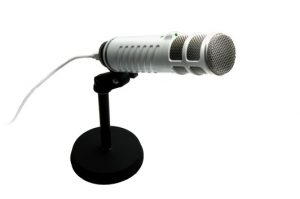
Microphones for podcasting
Tape or dynamic? Lamp or condenser? What should be the ideal microphone for a home studio for podcasting that can provide high-quality professional sound in any conditions? If you care about such questions, let’s understand this together!
For everything, you need to choose your own special microphone. What are fraught with errors? In the best case – it is an overpayment. For example, you can buy an expensive studio microphone for recording Internet podcasts, for the normal operation of which you will need to buy additional equipment. As a result, digital audio with a high compression ratio will be uploaded to the Network, which, when compressed, will lose the quality for which you paid the money. Another podcaster will buy a microphone, which is specially “adapted” to such needs, which is also several times cheaper, which connects directly to the PC via USB because it already has a built-in audio interface. As a result, this podcaster will put on the Web an audio material of comparable quality, but with fewer troubles and more modest cash costs.
Next, you should determine the brand of your future purchase. In search of a good microphone, it necessary to pay attention to the brand, or rather its history. The choice of leaders in the music industry is a key factor in the selection of good equipment. Here, there is no advertising, here it is a question of quality, which is recognized by professionals.
Follow the link below and select your microphone for podcasting!

Microphones to comment YouTube videos
What do you need to attract subscribers to your channel? That’s right – a quality content. To create it, in addition to the video, you need a good sound recording.
If we are talking about sound recording for Youtube, then the requirements for an ideal microphone can be put forward the following:
- Clean recording quality – without noise, wheezing, etc.
- Ability to connect to a computer via USB.
- Work with any sound cards.
If you are shooting landplays, you do not need to buy expensive studio devices. In many cases, it will be enough to purchase headphones or webcams with a microphone.
Video bloggers use three types of non-professional microphones:
- Headphones with built-in microphone. Plus of this option is the most affordable price. However, they have a big minus – the lowest quality of sound among other devices.
- Stationary. This is not studio but ordinary stationary devices with a stand.
- Webcams with built-in microphone. This type is well-suited for recording flats.
Choosing a sound recorder for Youtube, consider the specifics of your channel and buy the device expediently. Perhaps, you do not need to spend money on an expensive studio model, but the budget option will be enough.

Choir microphones
Theater-choral microphones are suspended audio amplifiers, differing in miniature sizes and fixed under the ceiling.
Theater microphones are installed on almost all major theatrical stages. They are absolutely necessary for staging performances because it is necessary that the audience, sitting in the first and last rows, hear the speech of the actors well.
Suspended choral microphones are used for performances of ensembles and chorus in concert halls and churches. Sometimes, they are also used in conference rooms.
Choral microphones differ from other types of such devices not only by the type and method of attachment but also by technical characteristics. These are highly sensitive devices. Therefore, for the performance of choral groups, mainly omnidirectional choral microphones are used.
Theatrical-choir is usually equipped with a feedback blocking system, which eliminates the appearance of unpleasant sounds. Some models have wind protection, so they can be used in open areas.
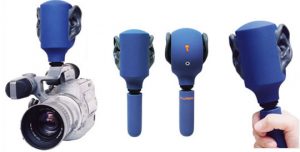
Binaural microphones
Almost always, the binaural is written on two spaced-up microphones. During playback, the track from each microphone is fed into a separate ear. Together, these tracks create a seemingly voluminous sound field in the listener.
The realism of recording depends on what is between the microphones. In the simplest case, between the microphones there is an air gap equal to the distance between the ears, that is the average head diameter, then the record has a certain volume, but no more.
The most impressive result can be obtained by placing a mock-up of the head between the microphones (dummy head). Microphones should be placed in artificial ear canals. And, ideally, this should be the model of the listener’s head.
The microphones are needed to solve a huge number of tasks, in the cultural, industrial and public spheres. And at first glance, all microphones have a similar arrangement. But for each specific task, you need to select the appropriate microphone. Therefore, we have examined the main characteristics that manufacturers point out to understand how to apply specific types of microphones since an incorrectly selected microphone can significantly reduce the recording quality or the effect of live performance.

